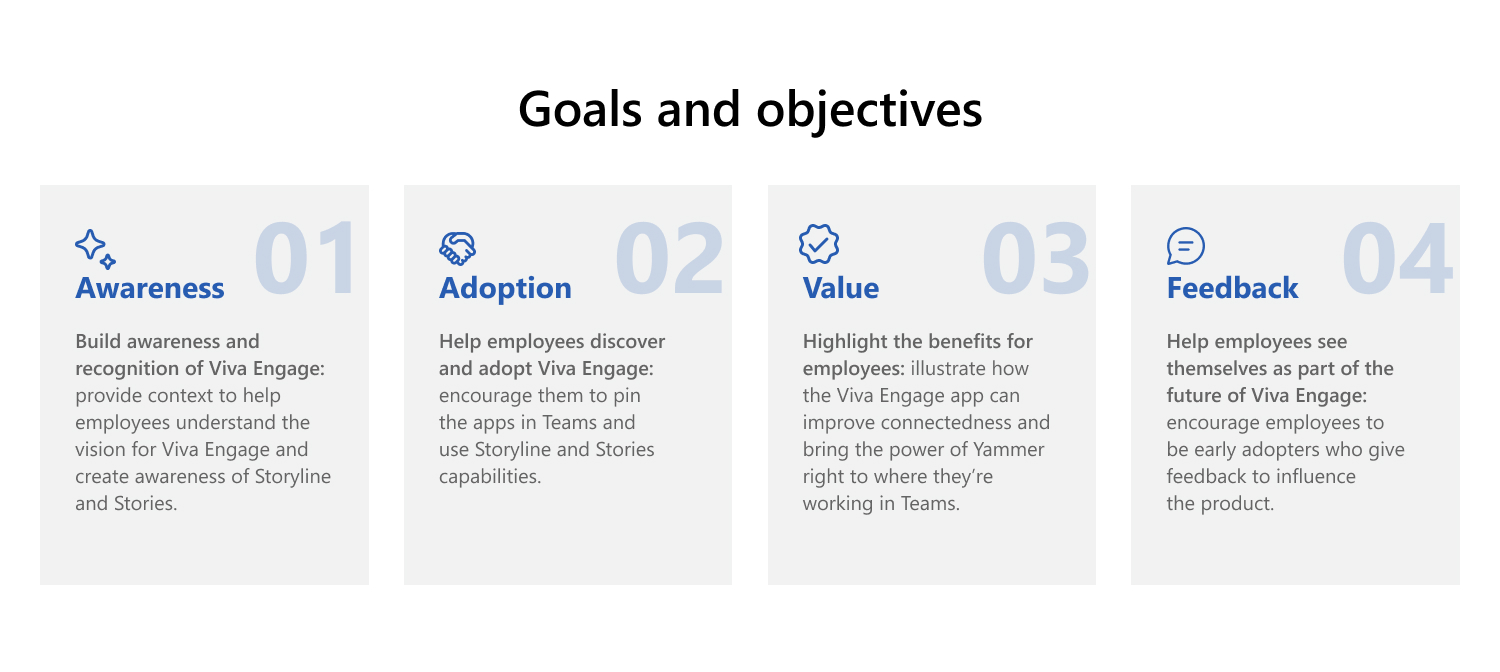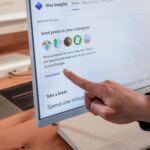 Keeping people connected in a hybrid work world is no easy task. But with the right technology, you can help employees in newly reimagined work environments feel energized and engaged, even when coworkers can’t be physically present.
Keeping people connected in a hybrid work world is no easy task. But with the right technology, you can help employees in newly reimagined work environments feel energized and engaged, even when coworkers can’t be physically present.
That’s exactly what we designed Microsoft Viva Engage to do.
To capture those benefits, we rolled out Microsoft Viva Engage’s newest features to our hundreds of thousands of employees here at Microsoft. Making this happen required a cross-disciplinary team of product specialists, change management practitioners, communicators, and executive sponsors.
We’re creating an environment where deep, meaningful human connection is ambient. If we solve for that, we won’t have this perceived dichotomy between flexible or hybrid work and employees who feel connected.
—Chris Owen, Microsoft Viva program manager, Human Resources
[Learn about all the ways Microsoft Viva is making work life better at Microsoft. See how we’re redefining the digitally assisted workday. Find out about Microsoft’s employee-centric experience.]
Keeping connected in the modern work world
Microsoft Viva Engage is the next evolution of our enterprise social platform Yammer, giving our employees a place to connect, express themselves, and find belonging that builds meaningful relationships at work. We’re using it to transform the way we do corporate communications. And while Viva Engage helps all employees connect, its latest features unlock especially powerful ways for our senior leaders to connect with people across their organizations and people with each other across organizations and networks.
We wanted to make sure we were telling the right story and reaching the right people. So we started thinking about how we could best help leaders understand how Viva Engage could make their jobs easier.
—Melissa Cafiero, communications and readiness lead, Microsoft Digital
“We’re creating an environment where deep, meaningful human connection is ambient,” says Chris Owen, Microsoft Viva program manager with Microsoft Human Resources. “If we solve for that, we won’t have this perceived dichotomy between flexible or hybrid work and employees who feel connected.”
We started using Microsoft Viva in helpful new ways starting in in Fall 2022:
- Leadership Corner is a dedicated space for communications and connecting with leaders.
- AMA (Ask Me Anything) events give leaders and employees the chance to make direct connections through Q&As with their colleagues.
- Employee Resource Group brings together employees who can support each other, share ideas, and build community.
- Storyline announcements deliver messaging directly to a leader’s most appropriate audience.
- Social campaigns rally people around shared initiatives through common social media behaviors.
- Analytics demonstrate value and guide behaviors through testing and learning.
- Answers, the latest feature, provides a crowdsourcing forum where employees can get their questions answered.
These features perfectly position Microsoft Viva Engage for a leadership-driven approach to adoption.
Building a strategy for success
The adoption team’s first challenge was finding a way to earn buy-in from our senior leaders. Microsoft Viva Engage is an enterprise social app, and executives are our biggest influencers.
“We wanted to make sure we were telling the right story and reaching the right people,” says Melissa Cafiero, communications and readiness lead in our Microsoft Digital (MSD) organization. “So, we started thinking about how we could best help leaders understand how Viva Engage could make their jobs easier.”

Cafiero’s team partnered with a wide range of collaborators across HR, change management, and product to build a strategy for reaching the executive community.
“We started digging into the size of this audience and the breadth of communication roles at Microsoft,” Cafiero says.
One group stood out: Global Employee and Executive Communications, a team known as GEEC. These professionals work with executives to craft internal communications, so they’re perfectly positioned to influence the influencers.
The adoption team started recruiting GEEC members into a new Early Adopter Program (EAP) for Microsoft Viva Engage. The program had three requirements:
- Become a superuser – Members were encouraged to set aside 30 minutes per week to learn about Microsoft Viva Engage.
- Collect insightful feedback – We asked them to share their insights with the adoption team to help us shape the features and direction of Viva Engage.
- Generate best-use scenarios – We encouraged them to actively use Viva Engage to find ways to promote adoption.
They also had the opportunity to join regular workshops, pop-up focus groups, a bespoke Microsoft Viva community within the app, and 1:1 follow-ups. As a result of this high-touch engagement, they had the comfort and confidence to use the tool in their everyday work and explain its value to executives.
“We started to see what they needed as corporate communicators to best leverage Viva Engage,” Owen says. “An important learning was that we shouldn’t be feature-focused but problem-focused. We asked what challenges these communicators face and began to co-create solutions for how they can best use this app to solve them.”
Viva Engage lets employees see you as someone approachable, someone who cares about them, and by using these features, you can build a culture of involvement that you couldn’t before.
—Paula Bohn, senior business program manager, change and adoption, MSD
Thanks to the adoption team’s work, we had buy-in from key members within the corporate communications discipline. They grew into an engaged group of superusers who were excited to apply Microsoft Viva Engage to their work with executives.
Building groundswell for Microsoft Viva Engage
With the release of leadership-focused features, we were in an excellent position to capture executive buy-in for the rollout.
“We talked to leaders about how employees often see executives as these unreachable entities,” says Paula Bohn, senior business program manager for change and adoption with MSD. “Viva Engage lets employees see you as someone approachable who cares about them, and by using these features, you can build a culture of involvement that you couldn’t before.”
Supported by the communications professionals in the EAP program, our leaders came to the table with a full understanding of Microsoft Viva Engage’s value and how it works. As a result, we had strong buy-in from our internal influencers.
One of the most successful activations came at the end of 2022, when we launched a Microsoft Viva Engage social campaign asking employees to look back over the last year: #2022Reflections. When Microsoft CEO Satya Nadella contributed his own reflection, it received over 200,000 impressions. That gave the adoption a massive boost.
“My change management team can jump through plenty of hoops to make adoption readiness happen, but a tool doesn’t actually land until employees see their leaders modeling the behavior,” Bohn says.
Microsoft Viva Engage shines through top-down deployment driven by senior leadership. But as it reached a critical mass of usage and engagement, the team took steps to reinforce adoption for all employees.
“Once we began to see leaders posting to their organizations in ways that weren’t possible before, the number of questions and requests for enablement quickly exceeded our capacity for white-glove treatment,” says Frank Delia, senior program manager for Office 365 services management and adoption with MSD. “That’s when we realized we needed to scale this information to meet demand.”
It’s not just about enabling leaders—everyone can take advantage of Microsoft Viva Engage’s capabilities. The best way to fuel Viva Engage usage is to drive interest in solving challenges that teams have and not on trying to get them to deploy a particular feature.

Company-wide adoption efforts included an extensive communication strategy featuring product documentation, in-tool directional supports, internal blogs, and all-employee emails, all while sourcing feedback from GEEC members and employees alike.
Paired with the excitement and engagement of connecting more closely with our top leaders, the groundswell of Microsoft Viva Engage usage continues to surge. As of March 2023, monthly active usage (MAU) for the Viva Engage app in Microsoft Teams stood at 71 percent of Microsoft employees. That’s nearly double its 38 percent MAU before we launched the new features in November, and much higher than our adoption target of 50 percent.
A roadmap for adoption success
At this point, Microsoft Viva Engage usage is high, and the feature sets are fully in place. The next steps are all about scale.
Now that this adoption is firmly established, Microsoft employees’ experience and feedback provide valuable insights for future deployments. Both the approach to communications and the EAP will feature heavily in our next big rollout.
“To me, adoption means users fully understand the product and its value, and they wouldn’t want to do without it.” Bohn says. “That’s the real measure of a successful adoption.”
The specific technology and key players may be different, but the core adoption process will remain our north star. It’s all about communicating value, capturing your key players, and making sure your technology meets your customers’ needs.

- Different approaches are valid for different tools, so select a top-down or bottom-up approach based on your use case.
- Be problem-focused—not feature-focused—to capture value for your key stakeholders.
- Be diligent about building a usage framework and differentiating use cases.
- Identify who your influencers are and who’s influencing them.
- Thoroughly research your target roles and their work.
- Train your early adopters and influencers extensively because other employees will follow their lead.

- Learn about all the ways Viva is making work life better at Microsoft.
- See how we’re redefining the digitally assisted workday.
- Find out how Microsoft is building an employee-centric experience.
Tags: digital transformation, employee engagement, Employee Experience, hybrid work








